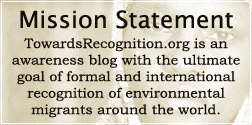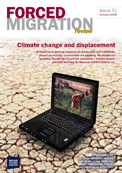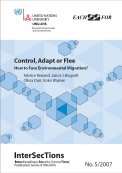(Reuters AlertNet) November 29, 2010 – The unsolved puzzle of what to do with people forced from their homes by the effects of climate change – a hot topic a couple of years ago – seems to have slid down the agendas of aid agencies, policy makers and the media.
Maybe we’ve grown
tired of recycled guesstimates of the numbers likely to be displaced by more extreme weather and rising seas, and the seeming lack of political will to help them in a concrete way.
Most journalists covering climate issues will already have written one or two features about people fleeing encroaching oceans on low-lying Pacific Islands or unable to return to storm-battered villages on the Bangladesh coast. Are we running out of fresh ideas, and if so, why?
These days, many researchers are wary of forecasting climate-related displacement in the coming decades, aware that their methodology will be scrutinised and often found wanting. Meanwhile, efforts to craft national and international laws and policies to fill the yawning gap on climate migrants crawl along with few tangible results.
The World Migration Report 2010, released over the weekend by the International Organization for Migration (IOM), is an attempt to remind governments of their responsibilities when it comes to displacement caused by sudden weather disasters or more gradual environmental changes, like shrinking water supplies.
The report opts for a low-key, nuts-and-bolts approach, exploring how to build on existing frameworks, and emphasising the duty of states to mitigate the threat from climate hazards to their populations, and to support those who have no alternative but to move within or across borders, either temporarily or permanently.
The report takes a conservative stance on statistics, saying that the best available data on environmental migration are probably the figures on people displaced by natural disasters. It cites a U.N. estimate from 2008, for example, of 20 million people uprooted as a result of sudden onset climate-related weather events.
“Migration resulting from environmental change is likely to continue to increase in the foreseeable future. The effects of climate change are likely to exacerbate this trend, although it is not always appropriate to ascribe environmental changes that might precipitate migration to climate change,” the report says cautiously, adding that deforestation, poor land management or a combination of factors could also push people to leave their homes for environmental reasons.
Overall, it says environmental change will contribute to raising the number of international migrants – estimated at 214 million in 2010 – to 405 million by 2050, if the rate of increase continues at the same pace as during the last 20 years.
GLOBAL DATABASE NEEDED
One of the report’s most interesting recommendations on environmental migration is to establish a global database on the phenomenon – a challenge that would require standardised definitions, the development of internationally comparable indicators and stronger capacities for national reporting. IOM says it, or another U.N. agency, may be best placed to lead such a project.
In preparation, it has proposed setting up an independent Commission on Migration and Environment Data (CMED) to develop practical guidelines on collecting and sharing information.
While international protection for climate “refugees” remains sorely lacking, the report says national laws and policies on internal displacement should be strengthened as a first step, given that most people uprooted by environmental change move within their own countries.
Currently, only around 30 countries have introduced legislation or strategies to implement the internationally agreed Guiding Principles on Internal Displacement, which explicitly include people displaced as a result of natural disasters.
And when it comes to movement across borders, the migration report says a short-term fix would be for states to amend their national immigration laws and policies in cases where the states neighbour or have strong migration links with countries or regions threatened by environmental change in the near future.
It cites a handful of countries that have made some provision. The United States, for example, allows foreigners already in the country to stay if they can’t go home due to an environmental disaster, and Sweden allows people affected by environmental disasters to seek asylum.
Colombia and Spain have an unusual example of a labour mobility programme that extends to populations in high-risk zones of natural disasters, the report says. But it makes clear that a comprehensive international framework for dealing with environmental migrants is still a long way off.
AFRICAN FARMERS AT RISK
Another piece of work that picks up the migration ball is a new study examining the potential impact of four-degree and above temperature increases on food production in sub-Saharan Africa, published in the journal Philosophical Transactions of the Royal Society Series.
By the 2090s, most of southern Africa could see growing seasons shortened by at least 20 percent, according to simulations carried out using various climate models, while eastern Africa could see modestly expanded seasons.
For sub-Saharan Africa as a whole, a temperature rise of five degrees would depress maize production by 24 percent and bean production by over 70 percent. And the rate of crop failure would increase in all parts of the region except Central Africa, with much of southern Africa’s rain-fed agriculture failing every other season.
“More frequent crop failures could unleash waves of climate migrants in a massive redistribution of hungry people,” lead author Philip Thornton of the Kenya-based International Livestock Research Institute (ILRI) warned in a statement.
ILRI Director General Carlos Sere told AlertNet the researchers had not tried to work out how many poor farmers could be forced from their land by climate change, but many in southern Africa would find their current practice of cultivating crops and rearing livestock – known as
“mixed farming” – no longer viable.
“They will have to give up their livelihoods and migrate. In areas where there may already be conflict and other stresses, this will create an enormous amount of tension,” he said.
Sere hopes the paper will act as a wake-up call to government officials gathering in Cancun, Mexico, this week for the annual U.N. climate conference.
There, amid lowered expectations for progress towards a global deal, environmental migration will have to jostle for position with a host of other climate change concerns, and pushing it back up the agenda looks set to be a fairly tough challenge.
Source: Reuters AlertNet



